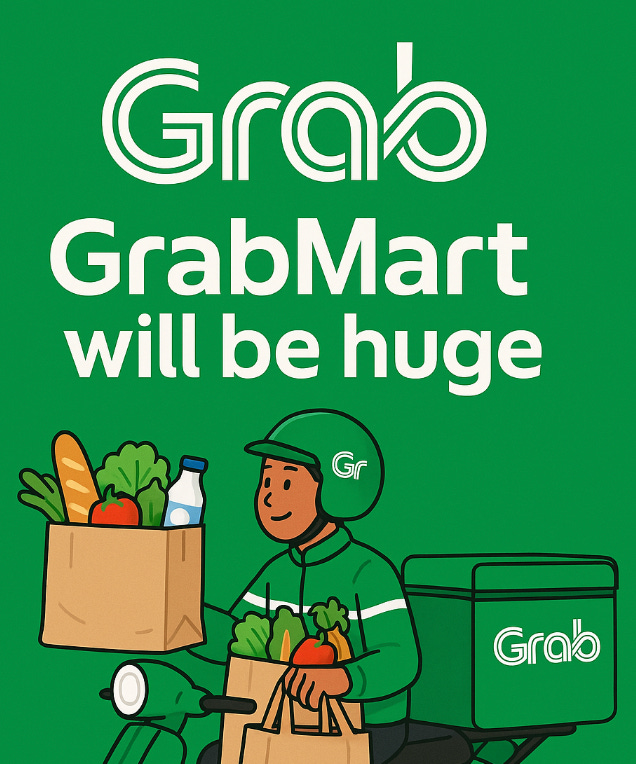Grab Mart!
Huge potential for grocery delivery in Southeast Asia.
In Grab's Q2 2025 earnings call, the management said that Grab Mart could potentially be much larger than the restaurant delivery business.
This threw me off guard, as their total deliveries GMV is close to $13B. So, they are saying that just Mart could be larger than that.
Now that I have had some time to think about it, I understand this comment and see where they are coming from.
In this quick article, I will explain why Grab Mart could potentially be a relatively much larger and more profitable business than groceries are for Uber or DoorDash.
If you want a more complete analysis of the company, I wrote a Deep Dive a few months ago and a Q2 2025 review a few weeks ago.
1. Grocery Delivery Penetration in Southeast Asia
Today, Grab Mart is less than 10% of deliveries GMV, yet it is growing 50% faster than restaurant delivery. This presents Grab with a massive opportunity to capture this fast-growing segment!
Online grocery delivery has around a 2-3% market share in Southeast Asia!
This is significantly below developed economies like the USA, Canada, Europe, and China.
In the USA, about 12% of all groceries are purchased online, Europe, between 10-14% depending on the country. Meanwhile, in China, the share is nearing 20%.
Thanks to economic growth, 200M people will join the Southeast Asian middle class. This will drive higher volumes for groceries, pushing online grocery delivery market share higher, enabling Grab Mart to grow. So, this segment will grow significantly just from the overall grocery delivery market, bridging the gap with more developed markets.
But there are additional factors increasing the opportunity.
2. Grocery Store Concentration
Through decades of M&A, the grocery store industry in developed economies has become extremely concentrated.
In the US, just the top 4 grocery giants control 67% of the grocery store industry, while in the UK, the top 4 control 75%!
In France, Germany, Australia, Spain, Canada, and other developed economies, the situation is very similar.
But that is not the case in Southeast Asia, where the majority of the market is controlled by small-scale, independently run grocery stores.
In developed markets, grocery stores have an incredible scale and negotiating power. They are able to demand better terms from their delivery partners, such as Uber, Lyft, DoorDash, and Instacart.
This means that Grab’s take rate could be higher in the long term in Southeast Asia than its counterparts in developed markets.
Higher take rates = Higher profits.
3. Ability and Willingness to invest in delivery infrastructure.
Another consequence of controlling 60%+ of the grocery store market and having massive scale is that these chains have billions of dollars of capital they can invest in automation and other investments to build their own in-house direct-to-consumer grocery delivery offerings.
This reduced the need for delivery apps!
Many of the largest grocery chains, such as Walmart, have the capital and the willingness to invest billions of dollars in technology, infrastructure, and the workforce to handle grocery delivery directly.
In fact, Walmart controls over 25% of the US online grocery market!
This is not the case in Southeast Asia. As I said, the majority of the market is small players. These businesses are usually family-run and don't have the capital, know-how, and willingness to build their own grocery delivery service.
Furthermore, even the larger chains are less likely to do it directly and more likely to just partner with Grab. This is because technological and logistics complexities that Grab can solve much better than they could.
This presents Grab with a potential to capture a significantly larger grocery delivery market share than the delivery apps have in developed markets.
4. Fewer Competing Apps
Moreover, due to Grab’s execution, the competitive landscape in Southeast Asia is starting to look much better than it is in developed markets.
While there are a lot of small niche apps and websites in certain countries,
there is no large competitor comparable to what Uber deals with, such as Instacart, Lyft, and DoorDash.
Gojek is a money-burning company involved in corruption scandals, which, after leaving Thailand and Vietnam, only operates in Singapore and Indonesia.
Foodpanda just left Thailand.
Bolt doesn't offer food delivery in the region.
E-commerce players are trying to enter this niche and might be successful, and could be the real competition.
But for now, none of the competitors can offer anything near the scale, product offering, convenience, and platform integration that Grab can.
This puts Grab in a more advantageous market position, enabling higher pricing and take-rates.
5. Grocery Advertising Business
Grab believes that there is a huge potential to have a very profitable advertising business in Grab Mart.
As I said, most grocery is sold through small players. This means that food companies such as Coca-Cola, Pepsi, Kraft Heinz, Nestle, and others often lack direct, reliable sales data and statistics.
Grab Mart can deliver the needed direct-to-consumer data streams that bypass this small retail system.
This makes Grab Mart's advertising data potentially valuable. Food companies can test advertising campaigns and new products on a large scale and then use the results to make changes across the region.
There is an opportunity for advertising revenues to have a healthy GMV conversion rate of 3-4%, more than the 1.7% now in the deliveries.
6. Conclusion
Simply put, online grocery delivery is growing fast.
Grab could have a much larger market share in the grocery delivery space because of higher industry fragmentation.
Take-rate could be higher because of stronger network effects and lower competition.
Advertising income as a share of GMV could be high, as food companies lack valuable local data for product and marketing iteration.
Overall, Grab Mart is poised to be a huge driver for the company in the future.
Thank you for reading Global Equity Briefing!
Global Equity Briefing is an investing newsletter with a focus on analysing global companies. I have written highly detailed Deep Dives on Nu Bank, Ferrari, Palantir, Grab, Celsius, Mercado Libre and Hello Fresh!
Additionally, I have written Investment Cases on Meta, Amazon and Google! and comparisons of Visa vs Mastercard and Eli Lilly vs Novo Nordisk!
My goal for 2025 is to write around 4-6 articles per month!
Subscribe to get all my articles as soon as they are released!
Support my work by becoming a paid subscriber!
You can follow me on Social Media below:
X(Twitter): TheRayMyers
Threads: @global_equity_briefing
LinkedIn: TheRayMyers
Disclaimer: Global Equity Briefing by Ray Myers
The information provided in the "Global Equity Briefing" newsletter is for informational purposes only and does not constitute financial advice, investment recommendations, or an offer or solicitation to buy or sell any securities. Ray Myers, as the author, is not a registered financial advisor, and readers should consult with their own financial advisors before making any investment decisions.
The content presented in this newsletter is based on publicly available information and sources believed to be reliable. However, Ray Myers does not guarantee the accuracy, completeness, or timeliness of the information provided. The author assumes no responsibility or liability for any errors or omissions in the content or for any actions taken in reliance on the information presented.
Readers should be aware that investing involves risks, and past performance is not indicative of future results. The author may or may not hold positions in the companies mentioned in the "Global Equity Briefing" report. Any investment decisions made based on the information in this newsletter are at the sole discretion of the reader, and they assume full responsibility for their own investment activities.




Interesting article – thanks for putting $GRAB on my radar. I agreed with the part about the “huge potential to have a very profitable advertising business”. So many other delivery companies (and retailers) across several verticals, have been helping their profit margins by adding more advertising. Because Advertising revenue comes with a higher GMV conversion than the base business – as you pointed out.